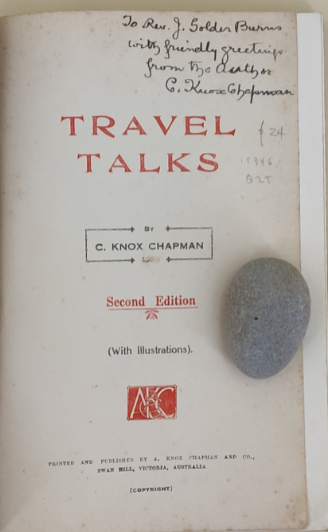HSV councillor 1944-1956. Proprietor and sub-editor, Swan Hill Guardian. Community worker.
Caroline (Carrie) Knox Chapman was born at Ballarat in 1877, the daughter of merchant Robert Jamieson and his wife Caroline Adelaide Atkinson. In April 1904, aged 27, she married Angus Knox Chapman, a widower with two sons not many years her junior at her father’s home in North Brighton.
Angus Knox Chapman was a man of some note in Swan Hill where the couple made their home. He had been involved in the Federation Movement in the 1890s and was president of the Federation League. He was also an office bearer of the Swan Hill Mallee Homestead League, the Agricultural Society and was president of the Swan Hill Mechanics Institute. He part-owned the local newspaper, the Swan Hill Guardian.
From the time of their marriage, Caroline (known as Carrie), joined her husband in local community work. There were no children of the marriage and she put her energies into local causes. She was an office bearer in the local branch of the Ministering Children’s League, the Swan Hill Ladies’ Benevolent Society, the Housewives’ Association and served as president of the local Australian Women’s National League (AWNL) branch, the Argus describing her in 1913 as an ‘enthusiastic Liberal’. During World War One both she and husband were heavily involved in local patriotic activities and she established the local Red Cross Branch, serving as its inaugural president. In the 1920s she added District Commissioner of Girls Guides to her portfolio of activities. (She established the company in Swan Hill).
Most of the year the Knox Chapmans lived at their home ‘Islay’ in Campbell Street, Swan Hill, but during the oppressive heat of the summer months, Carrie retreated to Melbourne, staying for months at a time at the Waldorf in St Kilda and later the Quamby Club which catered for country women visiting Melbourne. She also frequented country get-aways in the Yarra Valley and Mornington.
In 1928, Carrie travelled to Europe to attend a meeting of women’s political organisations in London as an AWNL delegate. She also visited Foxlease Hall, described by the Herald as ‘the Mecca of all Guides’. It was on her return from that trip that Carrie began writing. To begin with it was articles about the places she had visited, but then her first substantial publication, Travel Talks, was published in 1929.
She maintained her local activities and in 1931 became a JP when she was appointed special magistrate for the Swan Hill Children’s Court. Four years later she was the only woman to stand for the Swan Hill Shire elections, although she did not serve on Council. By then she was taking an active role in the Swan Hill Guardian, as part-owner with her husband and as sub-editor and writer. She belonged to the Press Council and in 1936 was the only woman Victorian delegate to the Australian Provincial Press Conference held in Brisbane.
After her husband’s death in 1937, she sold the Swan Hill Guardian. Although she described herself as a journalist on later electoral rolls, she had retired from journalism. She travelled for a while, then re-emerged in the press as a member of the National Council of Women and office bearer of the Business and Professional Women’s Club.
She had joined the Historical Society of Victoria in 1932. In 1944, aged 67, she became a councillor, the fourth woman to do so and the first from rural Victoria. The only other woman on Council at that time was Louise Bakewell, featured elsewhere in this biographical dictionary. In 1948, when Louise Bakewell resigned, Carrie Chapman was the only woman until Kitty McEwan (also featured in this biographical dictionary) was elected in February 1953.
By this time she was living partly in Melbourne and partly in Swan Hill and her attendance at council meetings was sporadic, the HSV president commenting in April 1951 that she had made a special trip from Swan Hill to attend the meeting. Nevertheless, she was able to contribute – by speaking at a meeting on the ‘Early History of the Churches of Swan Hill’ for example. When she sold her home in Swan Hill in February 1953 prior to moving to Melbourne, she offered lounge room furniture to the Society, some of which was stored in the hope that they would soon have their own premises to furnish and some of which was sold to help finance the work of the HSV.
Caroline (Carrie) Knox Chapman retired from RHSV Council in 1956 aged 79 and when she died the following year, she left the RHSV £100 in her will (about $3,500 today).
She is represented in the RHSV manuscript collection which hold her miscellaneous papers on the early history of Swan Hill, including the history of churches, settlers, Mallee pioneers and places. Her booklet, Jubilee history of John Knox Presbyterian Church, Swan Hill 1871-1921 is also in the collection.
Cheryl Griffin, 3 November 2023
Sources:
RHSV membership records
RHSV Council minutes
RHSV newsletters
RHSV M/S collection, MS 000261, Box 104/12
RSHV library collection
TROVE newspapers online
Victorian birth, death, marriage indexes
Victorian electoral rolls
UK Outward Shipping

Image caption: Travel Talks, inscribed by the author, C. Knox Chapman.

 239 A'Beckett Street Melbourne, Victoria, 3000
239 A'Beckett Street Melbourne, Victoria, 3000  03 9326 9288
03 9326 9288  office@historyvictoria.org.au
office@historyvictoria.org.au  Office & Library: Weekdays 9am-5pm
Office & Library: Weekdays 9am-5pm

